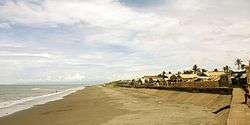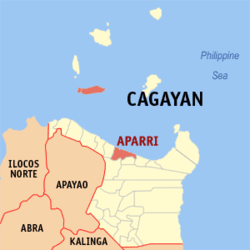Aparri
Aparri (Ibanag: Ili nat Aparri; Ilocano: Ili ti Aparri; Tagalog: Bayan ng Aparri), officially the Municipality of Aparri, is a 1st class municipality in the province of Cagayan, Philippines. According to the 2015 census, it has a population of 65,649 people.[3]
Aparri | |
|---|---|
| Municipality of Aparri | |
 | |
 Seal | |
 Map of Cagayan with Aparri highlighted | |
OpenStreetMap 
| |
.svg.png) Aparri Location within the Philippines | |
| Coordinates: 18°21′18″N 121°38′31″E | |
| Country | |
| Region | Cagayan Valley (Region II) |
| Province | Cagayan |
| District | 1st District |
| Barangays | 42 (see Barangays) |
| Government | |
| • Type | Sangguniang Bayan |
| • Mayor | Bryan Dale G. Chan |
| • Vice Mayor | Rommel G. Alameda |
| • Congressman | Ramon C. Nolasco Jr. |
| • Electorate | 36,350 voters (2019) |
| Area | |
| • Total | 286.64 km2 (110.67 sq mi) |
| Population (2015 census)[3] | |
| • Total | 65,649 |
| • Density | 230/km2 (590/sq mi) |
| • Households | 13,825 |
| Economy | |
| • Income class | 1st municipal income class |
| • Poverty incidence | 15.44% (2015)[4] |
| • Revenue (₱) | 171,923,111.22 (2016) |
| Time zone | UTC+8 (PST) |
| ZIP code | 3515 |
| PSGC | |
| IDD : area code | +63 (0)78 |
| Climate type | tropical monsoon climate |
| Native languages | Ilocano Ibanag Tagalog |
It sits at the mouth of the Cagayan River, the longest river in the Philippines, about 55 miles north of Tuguegarao, the provincial capital.
Aparri has an approximate income of ₱90 million. The valley has been one of the largest tobacco-producing sections in the Philippines, and the town has a considerable coastwise trade.[5]
It has a meteorological station located in Barangay Punta where the Cagayan River meets the Babuyan Channel.
It also administers Fuga Island, which is part of the Babuyan Group and is much closer to Claveria. In the near future, it is become the next city in the province of Cagayan.
History
Aparri was formerly a Japanese trading post because of its location at the northern tip of Luzon at the mouth of the Cagayan River. It was the main area for trade for Japan in the island of Luzon. Much of the area was once home to the native Ibanag people, who were at the time in alliance with Japan as an early form of an informal protectorate city-state. It was formally established under Spanish rule in 1605 after the Spanish Crown seized the Philippines and made it part of the Spanish East Indies. The river where Aparri is in was the site of the famed 1582 Cagayan battles, the only major skirmish between Spanish Tercios and Japanese Ronin (Masterless Samurai). Since it was on the route of Spanish Galleons during the great tobacco monopoly in the 16th to the 17th centuries, Aparri was therefore made one of the major Spanish ports of the Galleon Trade on May 11, 1680. The original inhabitants of this town were the Ybanags. Later, as the Spaniards settled and because of its strategic location, Ilocanos and Chinese people settled in the area.
In the years before the outbreak of World War II, it became a transshipment point for smuggled goods from China, Taiwan, and other neighboring Southeast Asian nations. Donald Blackburn's guerrilla forces and the local troops of the Philippine Commonwealth Army and Philippine Constabulary are supported the Sixth United States Army Force B, in the capture of Aparri on 20 June 1945.[6]:295–304
In 2006, work was started to rebuild the port, after the old pier deteriorated due to the rising level of water, the common storms, and poor construction (ruins of it are now seen washed up on the beach).
Barangays
Aparri is politically subdivided into 42 barangays.
- Backiling
- Bangag
- Binalan
- Bisagu
- Bukig
- Bulala Norte
- Bulala Sur
- Caagaman
- Centro 1 (Poblacion)
- Centro 2 (Poblacion)
- Centro 3 (Poblacion)
- Centro 4 (Poblacion)
- Centro 5 (Poblacion)
- Centro 6 (Poblacion)
- Centro 7 (Poblacion)
- Centro 8 (Poblacion)
- Centro 9 (Poblacion)
- Centro 10 (Poblacion)
- Centro 11 (Poblacion)
- Centro 12 (Poblacion)
- Centro 13 (Poblacion)
- Centro 14 (Poblacion)
- Centro 15 (Poblacion)
- Dodan
- Fuga Island
- Gaddang
- Linao
- Mabanguc
- Macanaya (Pescaria)
- Maura
- Minanga
- Navagan
- Paddaya
- Paruddun Norte
- Paruddun Sur
- Plaza
- Punta
- San Antonio
- Sanja
- Tallungan
- Toran
- Zinarag
Climate
Aparri has a tropical monsoon climate with warm temperatures year round though temperatures dip slightly during the winter months.
| Climate data for Aparri (1981–2010, extremes 1903–2012) | |||||||||||||
|---|---|---|---|---|---|---|---|---|---|---|---|---|---|
| Month | Jan | Feb | Mar | Apr | May | Jun | Jul | Aug | Sep | Oct | Nov | Dec | Year |
| Record high °C (°F) | 33.9 (93.0) |
35.8 (96.4) |
36.1 (97.0) |
38.4 (101.1) |
39.0 (102.2) |
38.0 (100.4) |
37.1 (98.8) |
37.5 (99.5) |
36.1 (97.0) |
36.2 (97.2) |
35.5 (95.9) |
33.2 (91.8) |
39.0 (102.2) |
| Average high °C (°F) | 27.6 (81.7) |
28.8 (83.8) |
30.6 (87.1) |
32.4 (90.3) |
33.1 (91.6) |
33.5 (92.3) |
33.1 (91.6) |
32.7 (90.9) |
32.4 (90.3) |
31.2 (88.2) |
29.9 (85.8) |
28.0 (82.4) |
31.1 (88.0) |
| Daily mean °C (°F) | 24.1 (75.4) |
24.9 (76.8) |
26.5 (79.7) |
28.0 (82.4) |
28.7 (83.7) |
29.1 (84.4) |
28.9 (84.0) |
28.6 (83.5) |
28.2 (82.8) |
27.4 (81.3) |
26.4 (79.5) |
24.6 (76.3) |
27.1 (80.8) |
| Average low °C (°F) | 20.5 (68.9) |
20.9 (69.6) |
22.3 (72.1) |
23.7 (74.7) |
24.4 (75.9) |
24.7 (76.5) |
24.7 (76.5) |
24.5 (76.1) |
24.1 (75.4) |
23.6 (74.5) |
22.9 (73.2) |
21.2 (70.2) |
23.1 (73.6) |
| Record low °C (°F) | 15.0 (59.0) |
13.7 (56.7) |
15.0 (59.0) |
16.0 (60.8) |
20.0 (68.0) |
17.8 (64.0) |
17.0 (62.6) |
20.0 (68.0) |
21.0 (69.8) |
19.0 (66.2) |
16.3 (61.3) |
15.0 (59.0) |
13.7 (56.7) |
| Average rainfall mm (inches) | 95.0 (3.74) |
56.5 (2.22) |
39.0 (1.54) |
40.2 (1.58) |
115.7 (4.56) |
157.6 (6.20) |
181.1 (7.13) |
191.1 (7.52) |
243.8 (9.60) |
295.9 (11.65) |
285.5 (11.24) |
186.6 (7.35) |
1,888.1 (74.33) |
| Average rainy days (≥ 0.1 mm) | 11 | 7 | 5 | 4 | 8 | 10 | 11 | 12 | 12 | 15 | 17 | 15 | 127 |
| Average relative humidity (%) | 86 | 85 | 84 | 84 | 83 | 83 | 83 | 83 | 84 | 85 | 86 | 87 | 84 |
| Source: PAGASA[7][8] | |||||||||||||
Demographics
|
| |||||||||||||||||||||||||||||||||||||||||||||
| Source: Philippine Statistics Authority[3][9][10][11] | ||||||||||||||||||||||||||||||||||||||||||||||
In the 2015 census, the population of Aparri, was 65,649 people,[3] with a density of 230 inhabitants per square kilometre or 600 inhabitants per square mile.
Tourism
Aparri is known for its foods such as the "bulung-unas", or Ribbon Fish (aka Belt Fish), which are in abundance during January and early February. "Kilawin naguilas-asan" is a fillet of smaller "bulung-unas" which are leftover baits, soaked in Ilocos vinegar, seasoned with salt and pepper, finely cut onions and ginger. Ludong, a variety of Pacific salmon, is the Philippines' most expensive fish, ranging from 4,000 pesos to 5,000 per kilo. Because of its price and its distinct taste and smell, it is also nicknamed "President Fish". Caught only in the Aparri delta when, after a heavy rainfall, these fish are washed down by the fast raging water from the south, down to the mouth of the Cagayan River where it meets the Babuyan Sea. Freshwater fish by nature, the salt water contributes to their super delicious taste. Ludong is available only in the rainy months of October and early November.
Aparri's attractions also include its sandy beaches and town fiesta. May 1 to 12 of every year, the town's fiesta celebrates the patron saint San Pedro Gonzales of Thelmo with nightly festivities at the auditorium, crowning of Miss Aparri beauty pageant and the "Comparza."
It is home to the Archdiocesan Shrine of Our Lady of the Most Holy Rosary and the Shrine of San Lorenzo Ruiz de Manila. Holy Week is celebrated in Aparri with the observance of Holy Thursday and Good Friday in the town churches. On the early hours of Easter Sunday, the "Domingo Sabet" celebrates the meeting of Jesus and the Holy Mother after the resurrection.
Municipal government
Elected officials 2019-2020:
- Mayor: Bryan Dale G. Chan
- Vice Mayor: Rommel G. Alameda
- Councilors:
- Darlene J. A. Dayag
- Norman N. Ignacio
- Victor R. Suguitan
- Joselito C. Albanio
- Jimmy U. Siriban
- Ria P. Capina
- John Paul Q. Decierto
References
- "Municipality". Quezon City, Philippines: Department of the Interior and Local Government. Retrieved 31 May 2013.
- "Province: Cagayan". PSGC Interactive. Quezon City, Philippines: Philippine Statistics Authority. Retrieved 12 November 2016.
- Census of Population (2015). "Region II (Cagayan Valley)". Total Population by Province, City, Municipality and Barangay. PSA. Retrieved 20 June 2016.
- "PSA releases the 2015 Municipal and City Level Poverty Estimates". Quezon City, Philippines. Retrieved 1 January 2020.
-

- Harkins, P., 1956, Blackburn's Headhunters, London: Cassell & Co. LTD
- "Aparri, Cagayan Climatological Normal Values". Philippine Atmospheric, Geophysical and Astronomical Services Administration. Archived from the original on 23 September 2018. Retrieved 23 September 2018.
- "Aparri, Cagayan Climatological Extremes". Philippine Atmospheric, Geophysical and Astronomical Services Administration. Archived from the original on 23 September 2018. Retrieved 23 September 2018.
- Census of Population and Housing (2010). "Region II (Cagayan Valley)". Total Population by Province, City, Municipality and Barangay. NSO. Retrieved 29 June 2016.
- Censuses of Population (1903–2007). "Region II (Cagayan Valley)". Table 1. Population Enumerated in Various Censuses by Province/Highly Urbanized City: 1903 to 2007. NSO.
- "Province of Cagayan". Municipality Population Data. Local Water Utilities Administration Research Division. Retrieved 17 December 2016.
External links
| Wikimedia Commons has media related to Aparri, Cagayan. |